Environmental Indicators: Resource Use
Editor’s Note: This is the second in a series written by Ann Arbor city staff on the environmental indicators used by the city of Ann Arbor in its State of Our Environment Report.

Recycling totes and a trash cart await collection in Ann Arbor. The totes will be replaced with bins similar to the blue trash cart in mid-2010. (Photo by The Chronicle.)
Although Matt Naud, the city’s environmental coordinator, is listed as the author of this piece, he received “a boxload of help” from Adrienne Marino, Tom McMurtrie, and Nancy Stone.
The SOE report is developed by the city’s environmental commission and designed as a citizen’s reference tool on environmental issues and as an atlas of the management strategies underway that are intended to conserve and protect our environment. The newest version of the report is organized around 10 environmental goals developed by the environmental commission and adopted by the city council in 2007. This installment focuses on responsible resource use.
All installments of the series are available here: Environmental Indicator Series.
With the closing of the 2009 holiday season, and many of us surrounded by lots of new “stuff” – including the associated boxes and packaging – and even a few of us with New Year’s resolutions to “simplify” our life in the coming new year, it seems like a good time to talk about all of the stuff we buy, use, reuse, recycle, and then throw out in Ann Arbor.
This year, coincidentally, is also the start of our 40th year of recycling in Ann Arbor, starting with a drop off station at Arborland in 1970, some curbside collection in 1978, and in 1991, an environmental bond that brought curbside collection to all Ann Arbor residents.
This installment of the series summarizes our environmental indicators on municipal solid waste (MSW) – the total amount of waste that is landfilled, composted, or recycled in our community.
Putting waste into a landfill has financial and environmental costs. So we look to recycling and composting rates as a measure of success, because recycling and composting divert waste from landfills. Recycling is also one of the least expensive ways for the city to reduce its carbon footprint. The energy used to recycle materials is typically far less than the energy used to create products from virgin materials.
Achieving our current goal of 60% diversion, and our ultimate goal – to produce zero waste – will require more hard work.
Overall, Ann Arbor diverts a large proportion of its total waste compared to other communities statewide as well as nationwide. We begin with a look at national and state patterns, before focusing on Ann Arbor’s indicators.
National Diversion Efforts
Let’s start by taking a look at the national level. The EPA reports that, “In 2008, Americans generated about 250 million tons of trash and recycled and composted 83 million tons of this material, equivalent to a 33.2 percent recycling rate. On average, we recycled and composted 1.5 pounds of our individual waste generation of 4.5 pounds per person per day.”
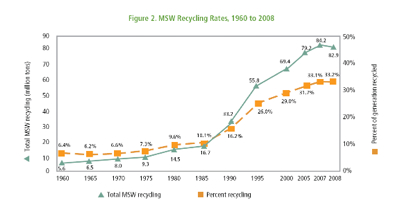
National municipal solid waste (MSW) recycling rates from 1960-2008. In green is the total tonnage recycled. In orange is the percent of the total stream that is recycled. The divergence of the graphs after 1990 means that even though total recycling has gone up, the U.S. has generated an even greater amount of waste.
Overall in the U.S., 54% of total Municipal Solid Waste (MSW) is discarded in landfills – the rest is recovered through recycling or combusted (i.e., burned) with some energy recovery. [Ann Arbor does not burn any of its waste.]
How does Michigan compare to the rest of the U.S.?
State Of Michigan’s Diversion Efforts
The following is taken from Expanding Recycling in Michigan, April 2006, a report prepared by Public Sector Consultants Inc. for Michigan Recycling Partnership:
Ironically, while Michigan is nationally recognized as a leader in conservation and environmental protection, the state is woefully behind its neighboring states and the nation in its MSW recycling efforts.
- Michigan’s recycling rate of 20 percent is lower than the other Great Lakes states (30 percent) and the U.S. (27 percent) averages.
- Michigan’s recycling rate decreased by 20 percent from 1994 to 2004, while every other state in the region had at least a marginal increase in recycling.
- The per capita recycling rate (0.38 tons/year/person) has remained almost stagnant and continues to be below the regional and national averages (0.44 and 0.46, respectively).
- Unlike many states, Michigan does not collect or require reporting of MSW recycling data; therefore, Michigan does not have the ability to measure the state’s recycling performance or its handling, collection, transport, and marketing of recyclable materials.
- Michigan’s recycling program is funded at a fraction of the level of other Great Lakes state programs and ranks 41st out of 48 states that reported their allocations for recycling.
- Only 37 percent of Michigan residents have access to curbside recycling, the lowest percentage of all the states in the region.
- Michigan has not invested in developing or sustaining markets for recycled materials, and some businesses have to import recycled materials from other states because of the inconsistency in local supplies.
So the Michigan story is pretty sad. A recent press release by the Michigan Department of Natural Resources and Environment reported on the decline in solid waste disposal in Michigan and the financial effects:
DEQ Interim Director Jim Sygo warned that the sharp decrease in solid waste disposal would impact the state’s ability to ensure that its waste stream was safe and protective of the environment.
“Michigan’s solid waste program is funded from a 21-cents-per-ton fee on solid waste disposed in Michigan landfills,” said Sygo. “This continued decline in disposal means fewer resources available to our department, and has serious implications for Michigan’s ability to continue the current level of permitting, inspections, and oversight of solid waste management in the state.”
Michigan’s 21-cents-per-ton fee is the lowest in the Great Lakes Region. Based on the capacity used during FY 2009, the reduction of waste disposed, and additional permitted landfill capacity, it is estimated that Michigan landfills have approximately 25 years of remaining disposal capacity.
Maybe it’s just me, but using Michigan land to store trash ought to be really expensive.
Ann Arbor’s Diversion Efforts
Here in Ann Arbor, the story is happier for a number of reasons. Most important is the millage that provides sustainable funding for residential and commercial recycling, including the infrastructure to collect, sort and process these materials for resale. That’s a millage that the city council can enact under state enabling legislation – it appears as “CITY REFUSE” on Ann Arbor property tax bills.
Ann Arbor also has a long history of public education by local government and nonprofits highlighting the benefits of recycling. The Ann Arbor recycling program started in 1970 with a grassroots effort that has continued to today. We have over a 90% participation rate in our single and multi-family recycling program.
Where do we want to be?
One of the city’s 10 environmental goals – responsible resource use – is to produce zero waste. Zero waste is an ambitious goal, but it effectively captures the idea that as a community we don’t want to be wasting resources. While we are not close to meeting the goal of zero waste, every five years we develop a solid waste plan for the city that sets intermediate targets. As we implement the solid waste plan, we move closer to meeting that larger goal.
The goals set in the most recent solid waste plan are:
Achieve a residential waste diversion rate of 60%, equivalent to 31,000 tons/year (for reference, the 1999/2000 recovery was 50%, equivalent to 26,000 tons/year), and an overall diversion goal (including the entire commercial sector) of 60%, equivalent to 40,200 tons/year for both residential and commercial locations.
Our residential waste diversion rate in 2008 was 54%.
Overall we are doing very well compared to measures at the national and state levels. There are several indicators we can use as we look at our overall waste, composting, and recycling initiatives.
Landfilled Waste Per Capita
One measurement the city uses as an indicator is the amount of landfilled waste per capita: How much stuff are we each generating on average and how does that compare with some national average?
This number is calculated by weighing the contents of the solid waste residential trucks and dividing by the current census population (excluding the University of Michigan). Looking at the chart below, the amount of waste we are generating per person in Ann Arbor is pretty steady. The good news is that it is lower than the national average. The bad news is that our residential waste disposal is slowly going up instead of down.
So Ann Arbor’s indicator for total waste per capita is green (our current state is pretty good), with a level arrow (we’re not getting better and not doing dramatically worse).
But this isn’t the whole story.
Looking at annual waste by pound includes all the solid waste we put out to the curb in trash carts. Ways to make our landfilled waste numbers drop include reducing waste at the source (by selecting products in recyclable packaging and purchasing items in bulk) and recycling and composting more.
It is possible to compost food scraps at home (or use your sink disposal) so that heavy organic material that really doesn’t belong in a landfill never makes it into the “waste” stream. In addition, the city expanded our seasonal composting cart collection program this year in fall 2009 – residents can now put uncooked fruits and vegetable food wastes into the compost carts.
Total Landfilled Waste
We’ve already looked at the per-person numbers for landfilled waste. So now let’s take a look at the total amount of waste we landfill.
This is an important measure to look at because it quantifies the amount of material that is now a pure expense to the city and won’t provide any further value – that is, until the economics of mining landfills for materials starts to make sense.
These landfill tons include residential curbside, multi-family, and commercial locations. Data for 2002-2003 are estimated based on 2001 and 2004 data.
This chart shows that we are landfilling less now – in the late 2000s – than we were in the late 1990s. And unfortunately, we are landfilling more than we were just a few years ago.
So Ann Arbor’s indicator for total amount landfilled is yellow (fair) with a downward arrow (we’re doing worse than before).
One thing to note is that landfilling in Michigan is incredibly cheap and not for very good reasons. The true cost of landfilling in Michigan is still pretty high when all of the costs are considered – especially the potential for contaminated groundwater and soils, methane creation, and transportation costs (most recycling facilities are much closer than the landfilling sites).
Past state legislators permitted so much landfill capacity that the beautiful state of Michigan has become a cheap dumping ground for dozens of states and Canada, because Michigan now has a huge over-supply of landfill space. Competition among huge landfills makes the cost for burying trash – the tipping fee – one of the lowest in the U.S.
Even though it makes no sense for Toronto to ship trash to Michigan, Michigan has artificially made it economical for Toronto to send their garbage to us. In FY 2008, Michigan residents sent 39,913,636 cubic yards of waste to Michigan landfills. Canada gave us another 10,722,164 cubic yards, and 6,484,096 came from other states for a grand total of 57,119,896 tons buried in the state of Michigan in just one year.
There are costs that Toronto and other states are not paying that will someday be paid for by Michigan residents.
Recycling
Recycling is one way to reduce the landfill numbers we’ve already looked at. In Ann Arbor, curbside recycling is provided by Recycle Ann Arbor through a contract with the city. Currently, residents use two stackable totes – a green one for containers and a gray one for paper material.
Ann Arbor’s indicator for total recycled material is green (good) with a level arrow (steady). So what kind of numbers does that indicator reflect?
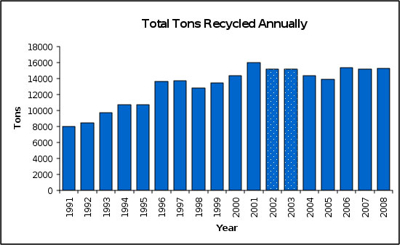
After a steady rise through the 1990s, the total tons of recycled material in Ann Arbor has leveled off or dropped a bit through the 2000s.
We have dropped a bit in the total amount of material recycled since a high in 2001, but overall our recycling rate has been steady for the past nine years.
To get that arrow for the indicator pointing up is one of the reasons we are looking at single-stream recycling to start in mid-2010 as a way to make recycling easier – toss everything in one cart – to boost our recycling rate and overall amount of waste we are diverting from landfills.
The city currently collects 357 pounds of recycleables per household (HH) per year. Single-stream recycling is expected to raise that amount by 100 pounds to 457 lbs/HH/year. Based on other communities, the addition of the RecycleBank rewards program is estimated to increase recycling to 752 lbs/HH/year – more than doubling the recycleables collected in Ann Arbor. These estimates also account for the expected drop in our total tons recycled because of the loss of the local daily newspaper in 2009.
Composting
Keeping organics that could be composted out of landfills is another way to reduce our landfilled waste numbers.
Ann Arbor’s environmental indicator is green (good) with an upward arrow (improving). What are the numbers that support Ann Arbor’s composting indicator?
Like recycling, the amount of composted material rose steadily through the 1990s. But composting rates then leveled out, with a big drop in 2007. The numbers for 2008 show us heading back in the right direction. The recent drop is because of a city council ban on grass clippings. They made manually-emptied cans very heavy – but grass clippings are now accepted in the new automated compost carts.
Composting rates are variable and depend on weather – if the year is wet or dry, along with other climatic factors such as ice storm damage, that influences the amount of vegetation collected.
Also, the loss of all the city’s ash trees over the past decade due to the Emerald Ash Borer took a toll by eliminating an estimated 11% of the city’s entire urban forest. Beginning in July 2008, residents began using carts or paper yard waste bags for their compostables. In the fall of 2009, pre-consumer uncooked vegetative food wastes began being accepted in the compost carts’ seasonal pickups.
Total Solid Waste: Landfilled, Recycled, Composted
Looking at the individual components of the waste stream – what gets landfilled, recycled, or composted – is definitely useful. But it’s also important to look at the big picture.
When you take a look at the overall picture of waste that is landfilled, recycled, or composted, you get a composite that looks like this.
It appears that the total amount of waste is down from the high in 2001 but our total waste has been creeping up since 2004.
The measure we look at for an indicator is the percentage of the total waste that is diverted – that is, either recycled or composted. This percentage of diversion is also known as the “recovery rate.”
Ann Arbor’s indicator for total amount of waste diverted is green (good) with a level arrow (stable).
Waste diversion is still fairly high at 41% (citywide, including both commercial and residential) and well above national and state averages. However, it is still lower than our previous high of 46% and well under our intermediate solid waste plan goal of 60%. When we look at just the residential waste stream, we are diverting 54% of the waste stream from landfills.
In 2000, a survey of comparable university communities was developed to benchmark Ann Arbor with peer communities.
Boulder Champgn Madison Minnpls OrgnCty Portlnd AnnArbor Pop. 110,700 64,280 200,800 358,785 107,000 505,000 112,000 HH 37,500 24,500 59,200 114,000 48,200 132,000 46,000 SW/day 3.00 3.00 2.53 2.46 3.79 2.75 2.70 PctDiv 36.40 28.20 46.30 29.40 32.20 50.30 39.60 PctRcy 30.40 5.90 19.10 16.60 25.00 27.40 21.60 PctCmp 6.00 22.30 27.20 12.70 7.20 22.90 18.00 ReCurb 513 155 501 384 479 661 727 ReTot 983 203 567 471 345 889 511 Yard 193 771 809 360 401 742 521
-
It’s About More than Garbage: Climate
Diversion of material from landfills helps with the management of our solid waste, but it also has a positive impact on reduction of greenhouse gas (GHG) emissions. Emissions of GHGs is an environmental indicator that’s classified by the city as a part of a different environmental goal: stable climate. We’ll take a look at that goal later in this series.
But it’s worth taking a brief look at the relationship between solid waste management and greenhouse gas emissions.
The following is taken directly from USEPA, Methodology For Estimating Municipal Solid Waste Recycling Benefits November 2007:
The disposal of solid waste produces greenhouse gas emissions in a number of ways. First, the anaerobic decomposition of waste buried in landfills produces methane, a greenhouse gas 21 times more potent than carbon dioxide. Second, the incineration of waste also produces carbon dioxide as a by-product. [Note: Ann Arbor does not currently burn any of its waste.] Additionally, in transporting waste for disposal, greenhouse gases are emitted due to the combustion of fossil fuels. Finally, fossil fuels are also required for extracting and processing the raw materials necessary to replace those materials that are being disposed with new products.
The national MSW recycling rate in 2006 was 32.5% (or 82 million tons). Using a WAste Reduction Model (WARM), the EPA has estimated the impact of that 82 million tons of recycling on total GHG emissions: It’s the equivalent of 1,288 trillion BTU – enough to power 6.8 million American households.
In 2003, a team of master’s students from the University of Michigan developed a climate action plan for the city. Using the EPA WARM model, they estimated the emissions avoided in Ann Arbor for the 10-year period from 1991-2001. Note: We have not updated these numbers (yet) using the latest recycling and composting numbers. Here, MTCO2e is the metric ton carbon dioxide equivalent:
Year Recycling Composting Total MTCO2e 1991 20,983.02 977.45 21,960.47 1992 22,075.72 1,356.75 23,432.47 1993 25,630.61 1,530.75 27,161.36 1994 28,098.70 1,737.45 29,836.15 1995 28,254.14 1,973.70 30,227.84 1996 35,740.40 2,184.40 37,924.80 1997 35,997.50 2,865.00 38,862.50 1998 33,570.73 2,302.80 35,873.53 1999 35,247.17 2,262.00 37,509.17 2000 37,713.29 2,397.40 40,110.69 2001 42,086.72 2,536.20 44,622.92 TOTAL 345,398.00 22,123.90 367,521.90
-
Following the EPA’s conversion, the 20,000-45,000 range of MTCO2e would translate to a range of savings equal to the energy needed to power 750-1,500 households.
Paths to Contribution
One of the goals of this series is to present some information about who’s already working on improving the city’s indicator scores, and to suggest some specific ways that members of the community can contribute to achieving the city’s environmental goals.
All solid waste, recycling, and composting efforts by the city of Ann Arbor are summarized on the city’s website: “Solid Waste and Recycling”
What can you do on a personal level? First, if you have less stuff, there is less to manage.
Second, reuse the stuff you have. The Reuse Center on South Industrial Avenue is one of several local groups that take items that are still in good shape. You get the tax deduction for your donation, and someone else gets an item they need (or just want more than you do) at a pretty good price. It also doesn’t end up in a landfill.
Personally, I have a new mantle over our fireplace that came from the reuse center, a series of low voltage halogen lights along our entry way, and a Rube Goldberg canoe carrier made from two recycled golf bag carriers. Other local reuse locations are listed online on the city’s website: “Reuse Options”
Third, what you can’t reuse, recycle. That should get easier soon. In mid-2010 the city’s residential and commercial weekly recycling collection program will be expanding to a single-stream program. As part of the upgrade of the city’s materials recovery facility (MRF), Ann Arbor will add and recycle clean plastic bottles and household rigid containers marked #1, #2, #4, #5, #6, and #7. Bulky plastic HDPE #2 items such as buckets, crates, trays, outdoor furniture, and many toys will be accepted.
Three types of plastics that will not be included in the expanded program include items marked with a: #3 (PVC for polyvinyl chloride), polystyrene foam (aka Styrofoam™), and plastic bags or film of any sort.
The city will continue to accept and recycle: glass bottles and food containers; tin/steel cans; aluminum cans, foil, and trays; metal scrap (such as pots and pans up to 1 square foot and 20 pounds/piece); milk cartons and juice boxes; newspapers; magazines and catalogs; corrugated cardboard (including pizza boxes free of food); paper bags; junk mail; office paper; boxboard (e.g., flattened cereal boxes); telephone books; and gift wrapping paper. Clean freezer food boxes will also be recyclable.
What about that old appliance you’d like to get rid of? Effective July 1, 2008, until further notice, the following electronic items are accepted at the Drop Off Station at Platt and Ellsworth at no additional charge beyond the per-vehicle charge of $3/visit: VCRs, stereos, microwave ovens, desktop computers, laptop computers, printers, fax machines, and copiers.
Other interesting efforts:
- Video on Recycling in Ann Arbor
- Ann Arbor Street Art Fair – Zero Waste Events
- Recycling at the University of Michigan
The purpose of sharing this indicator through The Chronicle is to share the State of Our Environment Report with the community and hear what you think. As the city’s environmental coordinator, I will be following any comments readers leave here.
Readers who’d prefer to send an email can use MNaud [at] a2gov.org. An easy chance for an in-person chat would be when the city’s environmental commission meets – the fourth Thursday of each month at 7 p.m. This month’s meeting is today, Jan. 28. Although meetings are typically held in the city council chambers at city hall, the January meeting will be a working session in the 6th floor workroom. City hall is located at 100 N. Fifth Ave.




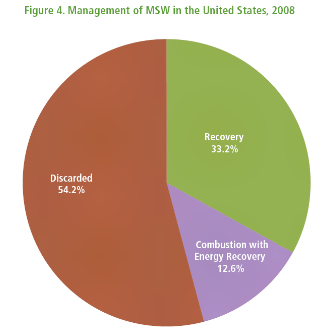
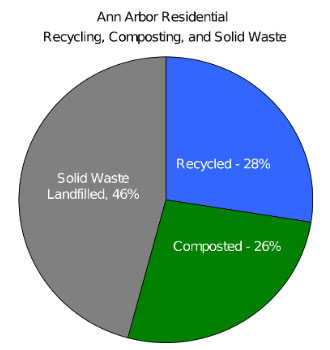

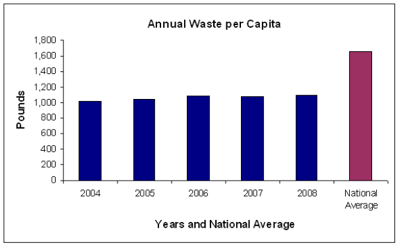



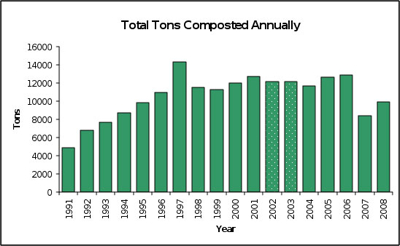

Great work Adrienne, Tom, Nancy and Matt! Thanks for your work.
Looking forward to the expanded recycling in mid-2010.